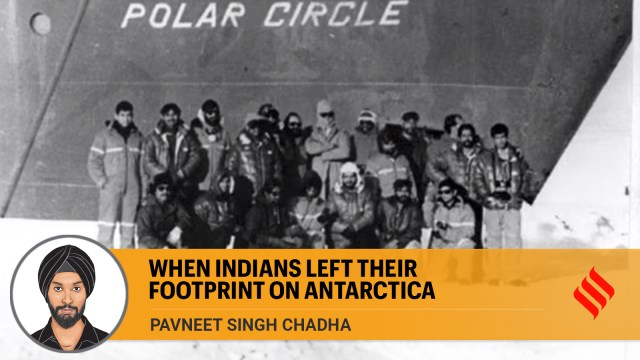
Forty-two years ago, on December 6, 1981, a 21-member crew of scientists, technicians and Navy personnel aboard a chartered Norwegian ship M V Polar Circle, quietly set sail from Goa’s Mormugao harbour.
Part of India’s first scientific expedition to Antarctica, code-named ‘Operation Gangotri’, the crew set foot on the coast of Queen Maud Land on the frozen continent a little over a month later, on January 9, 1982, and hoisted the Indian flag, marking India’s first foray into the icy realms of Antarctica. The group returned to Mormugao on February 21, covering over 21,000 km in 77 days.
After the Second World War, as Antarctica witnessed an upsurge in scientific exploration, several nations asserted territorial claims on the continent, based on their discoveries and expeditions.
India’s engagement with the ‘White Continent’ began as early as 1956 when India proposed an item titled ‘The Question of Antarctica’ on the agenda of the eleventh UN General Assembly, stating that the vast areas and resources of Antarctica be used entirely for peaceful purposes and for general welfare.
Amid concerns over mining and countries setting up military bases, in 1959, 12 countries signed the Antarctic Treaty. India wasn’t among the initial signatories. The Treaty prohibited military activity, nuclear testing and disposal of radioactive waste and underlined that Antarctica can only be used for peaceful purposes and for scientific investigation and research. Mineral exploitation, except for scientific research, was prohibited.
In 1960-61, an Indian biologist, Dr Giriraj Singh Sirohi, spent 100 days in sub-zero temperatures of the South Pole at McMurdo Station as part of the United States Antarctic Research Program. The same year, an Indian meteorologist, Lt Ram Charan, went south to the Wilkes Station, as an Indian government observer with Australian National Antarctic Research Expeditions.
But it was another Indian who became the first from the country to circumnavigate Antarctica and winter-over the South Pole. Under a joint Indo-Soviet agreement, Dr Parmjit Singh Sehra, then a young researcher at the Physical Research Laboratory (PRL), Ahmedabad, spent 18 months in 1971-1973 as the Project Scientist, “carrying out the upper atmospheric meteorological rocket soundings from the main Soviet station Molodezhnaya (in Antarctica)”.
In his diary notes, which he later published as A visit to the South Pole, Dr Sehra recounted his odyssey to the most remote station in Antarctica.
On the “harsh winter” and the food shortages the team had to endure, Sehra wrote, “…an emergency was declared at our station due to the acute shortage of food and other essential provisions… Our tinned food also got exhausted during the extremely cold and stormy polar night. As a consequence, we had to live on Antarctic seals, penguins and fish. I remember my days in Antarctica when we also had to eat the meat of our favorite huskies [that pulled sledges] in order to survive,” he wrote.
While his voyage may have sparked interest in a deeper scientific exploration of Antarctica, the plan to send an expedition only took shape under former prime minister Indira Gandhi, who set up the Department of Ocean Development in May 1981.
Operation Gangotri was kept under wraps, amid uncertainties about the outcome and the possibility of sabotage. Over the next few months in 1981, a chartered vessel from Norway was hired, with backchannel diplomacy with NATO nations ensuring that the news did not leak.
A crew of 21, including oceanographers, meteorologists, biologists, geologists, a geophysicist, a radio communication expert and several navy personnel, were drawn up from seven different institutions across the country. They were led by marine biologist Dr S Z Qasim.
“The entire operation, starting from conception to us finally sailing off from Goa…was accomplished in just over four months. Our initial meetings were held behind closed doors. People like the Cabinet Secretary, Defence Secretary and the Chief of Naval Staff…they were addressing us and we were discussing strategy…and we were not allowed to tell any of this outside. We couldn’t tell our wives. We felt like we were in a James Bond movie,” Dr Amitava Sengupta, radiophysicist, a member of the first expedition, told The Indian Express.
In October, the crew was sent to Gulmarg for acclimatisation training. “We were also taken around the Bay of Bengal for seven days. There were six-seven of us who had to be trained, and because this was top secret, the trainers were not allowed to know what we were going to be trained for. So, he (the ship’s captain) gave us all kinds of training, even how to use a pistol. They thought we were being trained for some secret offensive operation,” said Dr Sengupta.
On December 6, 1981, the team set sail. It was 10 days later that the news broke. And when that happened, the operation was seen as India’s bid to mark its presence as a growing power, especially under the leadership of Gandhi. The British magazine ‘New Scientist’, in its February 1982 edition, reported the story under the headline, “Indians quietly invade Antarctica”. The foreign press, too, raised political questions regarding India’s ‘intentions’ in Antarctica, amidst tensions over control of the icy continent’s resources.
Sengupta said the initial few attempts to find a safe approach to land the vessel were unsuccessful. “We were all getting impatient. We thought they will just take us back. But finally, we landed. I still remember the sun was out and weather had cleared. We were greeted by penguins. We took a photo in front of the ship,” he added.